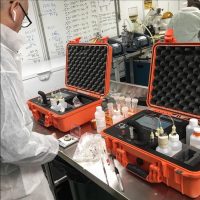In the last three articles, I discussed the laboratory’s responses or defenses used to reply to your questions about laboratory results that place stress on the success of your business. The Quality Control (QC) results can cause this stress if they are not run correctly to answer the following questions:
- Are the laboratory results really true?
- Can the laboratory accurately analyze sample products like my sample?
- Can the laboratory reproduce the sample results for my type of sample?
Now let’s discuss the most important QC test that will protect your crop and business. That QC sample is the Matrix Sample. In the last article in this series, you were introduced to many QC samples. The Matrix Sample and Duplicate were some of them. Take a look back at Part 3 to familiarize yourself with the definitions.
The key factors of these QC sample types are:
- Your sample is used to determine if the analysis used by the laboratory can extract the analyte that is being reported back to you. This is performed by the following steps:
- Your sample is analyzed by the laboratory as received.
- Then a sub-sample of your sample is spiked with a known concentration of the analyte you are looking for (e.g. pesticides, bacteria, organic chemicals, etc.).
- The difference between the sample with and without a spike indicates whether the laboratory can even find the analyte of concern and whether the percent recovery is acceptable.
- Examples of failures are from my experiences:
- Laboratory 1 spiked a known amount of a pesticide into a wastewater matrix. (e.g. Silver into final treatment process water). The laboratory failed to recover any of the spiked silver. Therefore the laboratory results for these types of sample were not reporting any silver, but silver may be present. This is where laboratory results would be false negatives and the laboratory method may not work on the matrix (your sample) correctly. .
- Laboratory 2 ran an analysis for a toxic compound (e.g. Cyanide in final waste treatment discharge). A known amount of cyanide was spiked into a matrix sample and 4 times the actual concentration of that cyanide spike was recovered. This is where laboratory results would be called false positives and the laboratory method may not work on the matrix (your sample) correctly.
- Can the laboratory reproduce the results they reported to you?
- The laboratory needs to repeat the matrix spike analysis to provide duplicate results. Then a comparison of the results from the first matrix spike with its duplicate results will show if the laboratory can duplicate their test on your sample.
- If the original matrix spike result and the duplicate show good agreement (e.g. 20% relative percent difference or lower). Then you can be relatively sure that the result you obtained from the laboratory is true.
- But, if the original matrix spike result and the duplicate do not show good agreement (e.g. greater than 20% relative percent difference). Then you can be sure that the result you obtained from the laboratory is not true and you should question the laboratory’s competence.
- The laboratory needs to repeat the matrix spike analysis to provide duplicate results. Then a comparison of the results from the first matrix spike with its duplicate results will show if the laboratory can duplicate their test on your sample.
Now, the question is why a laboratory would not perform these matrix spike and duplicate QC samples? Well, the following may apply:
- These matrix samples take too much time.
- These matrix samples add a cost that the laboratory cannot recover.
- These matrix samples are too difficult for the laboratory staff to perform.
- Most importantly: Matrix samples show the laboratory cannot perform the analyses correctly on the matrix.
So, what types of cannabis matrices are out there? Some examples include bud, leaf, oils, extracts and edibles. Those are some of the matrices and each one has their own testing requirements. So, what should you require from your laboratory?
- The laboratory must use your sample for both a matrix spike and a duplicate QC sample.
- The percent recovery of both the matrix spike and the duplicate will be between 80% and 120%. If either of the QC samples fail, then you should be notified immediately and the samples reanalyzed.
- If the relative percent difference between the matrix spike and the duplicate will be 20% or less. If the QC samples fail, then you should be notified immediately and the samples should be reanalyzed.
The impact of questionable laboratory results on your business with failing or absent matrix spike and the duplicate QC samples can be prevented. It is paramount that you hold the laboratory responsible to produce results that are representative of your sample matrix and that are true.
The next article will focus on how your business will develop a quality plan for your laboratory service provider with a specific focus on the California Code Of Regulations, Title 16, Division 42. Bureau Of Cannabis Control requirements.



































